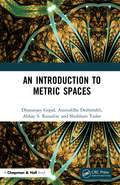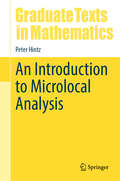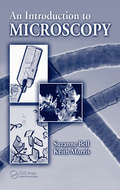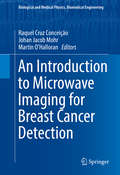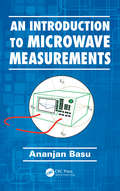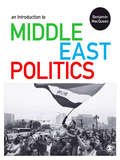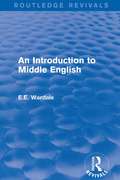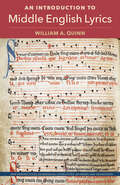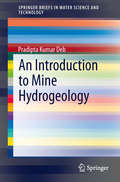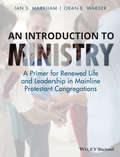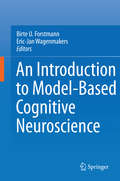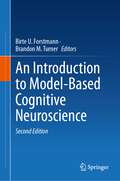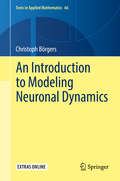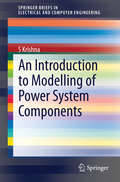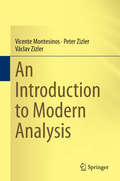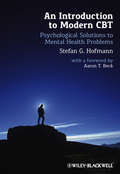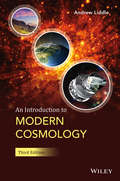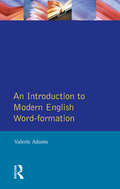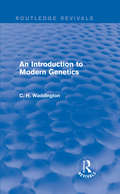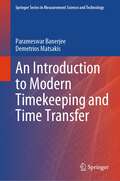- Table View
- List View
An Introduction to Metric Spaces
by Dhananjay Gopal Aniruddha Deshmukh Abhay S Ranadive Shubham YadavThis book serves as a textbook for an introductory course in metric spaces for undergraduate or graduate students. The goal is to present the basics of metric spaces in a natural and intuitive way and encourage students to think geometrically while actively participating in the learning of this subject. In this book, the authors illustrated the strategy of the proofs of various theorems that motivate readers to complete them on their own. Bits of pertinent history are infused in the text, including brief biographies of some of the central players in the development of metric spaces. The textbook is divided into seven chapters that contain the main materials on metric spaces; namely, introductory concepts, completeness, compactness, connectedness, continuous functions and metric fixed point theorems with applications. Some of the noteworthy features of this book include · Diagrammatic illustrations that encourage readers to think geometrically · Focus on systematic strategy to generate ideas for the proofs of theorems · A wealth of remarks, observations along with a variety of exercises · Historical notes and brief biographies appearing throughout the text
An Introduction to Microlocal Analysis (Graduate Texts in Mathematics #304)
by Peter HintzMicrolocal analysis provides a powerful, versatile, and modular perspective on the analysis of linear partial differential equations. This text, developed from a first-year graduate course, provides an accessible introduction and develops, from first principles, the core notions and results including pseudodifferential operators, wave front sets, and propagation phenomena. The reader is assumed to have some exposure to functional analysis and the theory of smooth manifolds. With detailed proofs, a wealth of exercises of varying levels of difficulty, and connections to contemporary research in general relativity, the book serves as both a comprehensive textbook for graduate students and a useful reference for researchers.
An Introduction to Microscopy
by Suzanne Bell Keith MorrisMicroscopy, which has served as a fundamental scientific technique for centuries, remains an invaluable tool in chemistry, biology, healthcare, and forensics. Increasingly, it is being integrated into modern chemical instrumentation and is of value as a powerful analytical tool across many scientific disciplines. Designed to serve as a primary reso
An Introduction to Microwave Imaging for Breast Cancer Detection (Biological and Medical Physics, Biomedical Engineering)
by Raquel Cruz Cruz Conceição Johan Jacob Jacob Mohr Martin O'HalloranThis book collates past and current research on one of the most promising emerging modalities for breast cancer detection. Readers will discover how, as a standalone technology or in conjunction with another modality, microwave imaging has the potential to provide reliable, safe and comfortable breast exams at low cost. Current breast imaging modalities include X- ray, Ultrasound, Magnetic Resonance Imaging, and Positron Emission Tomography. Each of these methods suffers from limitations, including poor sensitivity or specificity, high cost, patient discomfort, and exposure to potentially harmful ionising radiation. Microwave breast imaging is based on a contrast in the dielectric properties of breast tissue that exists at microwave frequencies. The book begins by considering the anatomy and dielectric properties of the breast, contrasting historical and recent studies. Next, radar-based breast imaging algorithms are discussed, encompassing both early-stage artefact removal, and data independent and adaptive beamforming algorithms. In a similar fashion, microwave tomographic reconstruction algorithms are reviewed in the following chapter, introducing the reader to both the fundamental and more advanced algorithms. Apart from imaging, the book also reviews research efforts in extracting clinically useful information from the Radar Target Signature of breast tumours, which is used to classify tumours as either benign or malignant. Finally, the book concludes by describing the current state of the art in terms of prototype microwave breast imaging systems, with a particular emphasis on those which have progressed to the clinical evaluation stage. This work is motivated by the fact that breast cancer is one of the leading causes of death amongst women in Europe and the US, and the second most common cancer in the world today. Such an important area of research will appeal to many scholars and practitioners. p>
An Introduction to Microwave Measurements
by Ananjan BasuGo Beyond Basic Distributed Circuit AnalysisAn Introduction to Microwave Measurements has been written in a way that is different from many textbooks. As an instructor teaching a master's-level course on microwave measurements, the author recognized that few of today's graduate electrical engineering students are knowledgeable about microwave measu
An Introduction to Middle East Politics
by Benjamin MacQueenThis new edition of An Introduction to Middle East Politics continues to provide an expansive survey of Middle East politics, thoroughly revised and restructured in response to events currently taking place. Written in a lively and accessible manner, MacQueen takes students on a tour of the region’s modern political history up to the present, clearly signposting key events and issues. Providing comprehensive coverage of all key themes in Middle East politics, this book covers: Historical Legacies; The Ottoman Empire, WWI, colonialism and the Cold War; nationalism and Islamist politics Authoritarianism in Egypt, Algeria and Syria; political changes in Iran; the politics of oil in Saudi Arabia and the Gulf States; Israel, the Palestinians and the Arab States The Syrian conflict including regional ramifications and particular focus on the Syrian refugee crisis Each chapter includes a timeline, learning objectives, study questions and annotated further reading and the book finishes with a glossary. Contemporary and fascinating, with dedicated material on culture, gender, ethnicity and minorities, this book is a crucial companion for students of Middle East politics.
An Introduction to Middle East Politics
by Benjamin MacQueenThis new edition of An Introduction to Middle East Politics continues to provide an expansive survey of Middle East politics, thoroughly revised and restructured in response to events currently taking place. Written in a lively and accessible manner, MacQueen takes students on a tour of the region’s modern political history up to the present, clearly signposting key events and issues. Providing comprehensive coverage of all key themes in Middle East politics, this book covers: Historical Legacies; The Ottoman Empire, WWI, colonialism and the Cold War; nationalism and Islamist politics Authoritarianism in Egypt, Algeria and Syria; political changes in Iran; the politics of oil in Saudi Arabia and the Gulf States; Israel, the Palestinians and the Arab States The Syrian conflict including regional ramifications and particular focus on the Syrian refugee crisis Each chapter includes a timeline, learning objectives, study questions and annotated further reading and the book finishes with a glossary. Contemporary and fascinating, with dedicated material on culture, gender, ethnicity and minorities, this book is a crucial companion for students of Middle East politics.
An Introduction to Middle East Politics: Continuity, Change, Conflict and Co-operation
by Benjamin MacqueenThe Middle East has undergone enormous change since 9/11, from the invasion and occupation of Iraq to the events of the 'Arab Spring'. An Introduction to Middle East Politics engages with questions of democratisation and political reform in the region. It covers: Historical Legacies; The Ottoman Empire, WWI, colonialism and the Cold War; nationalism and Islamist politics Authoritarianism in Egypt, Algeria and Syria; political changes in Iran; the politics of oil in Saudi Arabia and the Gulf States; Israel, the Palestinians and the Arab States Intervention in Afghanistan and Iraq The recent uprisings in the Arab World, human rights, social movements and social media Each chapter opens with helpful learning objectives and concludes with study questions. Annotated bibliographies aid further reading, whilst the companion website provides links to additional material. This book will prove a fascinating read for both undergraduate and postgraduate students of Middle East Politics and related courses across Politics and International Relations.
An Introduction to Middle English
by E.E. WardaleFirst published in 1937, this book supplies a history of the living growth of the English language from Old English to the medieval period. It offers an in-depth study of the growth of vocabulary through literature and social interaction, bringing out the fact that it is chiefly words that foreign influence has affected — leaving sentence structure almost unaltered. Isolative and combinative changes in phonology, the accidence of nouns and plurals, pronouns and adverbs, and verbs are also examined in detail, along with a general overview of the features Middle English and a brief outline of each dialect’s most striking characteristics.
An Introduction to Middle English Lyrics (New Perspectives on Medieval Literature: Authors and Traditions)
by William A. QuinnUnderstanding a medieval poetry genre through modern translations, commentary, and the role of performance Middle English lyrics are anonymous short poems that were composed between the twelfth and sixteenth centuries. They address a range of themes, both secular and religious, and usually emphasize the author’s personal relationship to the subject matter. In this introduction to the genre, William Quinn offers an overview of the large body of work, identifying common features and trends over time and discussing select examples in detail.Quinn argues that Middle English lyrics are best understood when read as emotional performances and guides readers through the poems’ expressions of joy, sorrow, anger, fear, compassion, spiritual devotion, romantic attraction, erotic frustration, and gender-targeted contempt. For the poems he considers in detail, Quinn provides line-for-line modern renditions of the Middle English texts. The book also includes commentaries keyed to the original texts, intended to prompt interpretations and enrich understandings of the lyrics. Quinn concludes by tracing the later development of versification from medieval to Renaissance lyrics, looking at work by Chaucer, Hoccleve, Petrarch, Wyatt, Surrey, and Shakespeare.An Introduction to Middle English Lyrics encourages readers to appreciate this literary genre on its own terms and to reconsider modern ideas of what makes a “good” poem. With a deeper knowledge of how lyrics functioned in their historical settings, this book fosters a reassessment of their significance to the broader history of English poetry. A volume in the series New Perspectives on Medieval Literature: Authors and Traditions, edited by R. Barton Palmer and Tison Pugh
An Introduction to Mine Hydrogeology (SpringerBriefs in Water Science and Technology)
by Pradipta Kumar DebAn Introduction to Mine Hydrogeology briefly describes the subject of hydrogeology so that this knowledge can be integrated into mine development planning. It emphasizes not only the hydrochemical but also the physical impacts of the hydrogeological environment on the mine and its surroundings. Further, it discusses the methodologies used in mine hydrogeological studies, showcased by selected studies on Indian mines.
An Introduction to Ministry: A Primer for Renewed Life and Leadership in Mainline Protestant Congregations
by Ian S. Markham Oran E. WarderAn Introduction to Ministry is a comprehensive and ecumenical introduction to the craft of ministry for ministers, pastors, and priests that make up the mainline denominations in the United States. Ecumenically-focused, It offers a grounded account of ministry, covering areas such as vocation, congregational leadership, and cultivation of skills for an effective ministry. Covers the key components of the M.Div. curriculum, offering a map and guide to the central skills and issues in training Explores the areas of vocation, skills for ministry, and issues around congregational leadership Each topic ends with an annotated bibliography providing an indispensable gateway to further study Helps students understand both the distinctive approach of their denomination and the relationship of that approach to other mainline denominations Advocates and defends a generous understanding of the Christian tradition in its openness and commitment to broad conversation
An Introduction to Model-Based Cognitive Neuroscience
by Eric-Jan Wagenmakers Birte U. ForstmannTwo recent innovations, the emergence of formal cognitive models and the addition of cognitive neuroscience data to the traditional behavioral data, have resulted in the birth of a new, interdisciplinary field of study: model-based cognitive neuroscience. Despite the increasing scientific interest in model-based cognitive neuroscience, few active researchers and even fewer students have a good knowledge of the two constituent disciplines. The main goal of this edited collection is to promote the integration of cognitive modeling and cognitive neuroscience. Experts in the field will provide tutorial-style chapters that explain particular techniques and highlight their usefulness through concrete examples and numerous case studies. The book will also include a thorough list of references pointing the reader towards additional literature and online resources.
An Introduction to Model-Based Cognitive Neuroscience
by Birte U. Forstmann Brandon M. TurnerThe main goal of this edited collection is to promote the integration of cognitive modeling and cognitive neuroscience. Experts in the field provide tutorial-style chapters that explain particular techniques and highlight their usefulness through concrete examples and numerous case studies. The book also includes a thorough list of references pointing the reader toward additional literature and online resources. The second edition of Introduction to Model-Based Cognitive Neuroscience explores important new advances in the field including joint modeling and applications in areas such as computational psychiatry, neurodegenerative diseases, and social decision-making.
An Introduction to Modeling Neuronal Dynamics
by Christoph BörgersThis book is intended as a text for a one-semester course on Mathematical and Computational Neuroscience for upper-level undergraduate and beginning graduate students of mathematics, the natural sciences, engineering, or computer science. An undergraduate introduction to differential equations is more than enough mathematical background. Only a slim, high school-level background in physics is assumed, and none in biology. Topics include models of individual nerve cells and their dynamics, models of networks of neurons coupled by synapses and gap junctions, origins and functions of population rhythms in neuronal networks, and models of synaptic plasticity.An extensive online collection of Matlab programs generating the figures accompanies the book.
An Introduction to Modelling of Power System Components (SpringerBriefs in Electrical and Computer Engineering)
by S KrishnaThe brief provides a quick introduction to the dynamic modelling of power system components. It gives a rigorous derivation of the model of different components of the power system such as synchronous generator, transformer, transmission line, FACTS, DC transmission system, excitation system and speed governor. Models of load and prime movers are also discussed. The brief can be used as a reference for researchers working in the areas of power system dynamics, stability analysis and design of stability controllers. It can also serve as a text for a short course on power system modelling, or as a supplement for a senior undergraduate/graduate course on power system stability.
An Introduction to Modern Analysis
by Vicente Montesinos Václav Zizler Peter ZizlerExamining the basic principles in real analysis and their applications, this text provides a self-contained resource for graduate and advanced undergraduate courses. It contains independent chapters aimed at various fields of application, enhanced by highly advanced graphics and results explained and supplemented with practical and theoretical exercises. The presentation of the book is meant to provide natural connections to classical fields of applications such as Fourier analysis or statistics. However, the book also covers modern areas of research, including new and seminal results in the area of functional analysis.
An Introduction to Modern CBT
by Stefan G. HofmannAn Introduction to Modern CBT provides an easily accessible introduction to modern theoretical cognitive behavioral therapy models. The text outlines the different techniques, their success in improving specific psychiatric disorders, and important new developments in the field.* Provides an easy-to-read introduction into modern Cognitive Behavioral Therapy approaches with specific case examples and hands-on treatment techniques* Discusses the theoretical models of CBT, outlines the different techniques that have been shown to be successful in improving specific psychiatric disorders, and describes important new developments in the field* Offers useful guidance for therapists in training and is an invaluable reference tool for experienced clinicians
An Introduction to Modern Cosmology
by Andrew LiddleA concise, accessible introduction to this exciting and dynamic subject.* Adopts an approach grounded in physics rather than mathematics.* Includes worked examples and student problems, along with hints for solving them and the numerical answers.* Many reviewers have commented that this is one of the best 'introductory undergraduate level' texts on the subject and they would all welcome a Second Edition.
An Introduction to Modern Cosmology
by Andrew LiddleAn Introduction to Modern Cosmology Third Edition is an accessible account of modern cosmological ideas. The Big Bang Cosmology is explored, looking at its observational successes in explaining the expansion of the Universe, the existence and properties of the cosmic microwave background, and the origin of light elements in the universe. Properties of the very early Universe are also covered, including the motivation for a rapid period of expansion known as cosmological inflation. The third edition brings this established undergraduate textbook up-to-date with the rapidly evolving observational situation. This fully revised edition of a bestseller takes an approach which is grounded in physics with a logical flow of chapters leading the reader from basic ideas of the expansion described by the Friedman equations to some of the more advanced ideas about the early universe. It also incorporates up-to-date results from the Planck mission, which imaged the anisotropies of the Cosmic Microwave Background radiation over the whole sky. The Advanced Topic sections present subjects with more detailed mathematical approaches to give greater depth to discussions. Student problems with hints for solving them and numerical answers are embedded in the chapters to facilitate the reader’s understanding and learning. Cosmology is now part of the core in many degree programs. This current, clear and concise introductory text is relevant to a wide range of astronomy programs worldwide and is essential reading for undergraduates and Masters students, as well as anyone starting research in cosmology.
An Introduction to Modern English Word-Formation
by Valerie AdamsA series to meet the need for books on modern English that are both up-to-date and authoritative.For the scholar, the teacher, the student and the general reader, but especially for English-speaking students of language and linguistics in institutions where English is the language of instruction, or advanced specialist students of English in universities where English is taught as a foreign language
An Introduction to Modern Genetics (Routledge Revivals: Selected Works of C. H. Waddington)
by C. H. WaddingtonFirst published in 1939 (second impression in 1950), this book provides an account of the changes in, and main principles of, genetics at that time. These are illustrated by references to the most authoritative and then recent investigations. Special attention is paid to the way in which genetics overlaps with other fields of inquiry, since it is often in these border-line subjects that the most important advances are to be expected. The book is particularly arranged to suit the convenience of students whose previous knowledge of genetics is small, and contains annotated bibliographies of suggestions for further reading.
An Introduction to Modern Japanese
by Richard Bowring Haruko Ury LaurieThis is the first book in a two-volume intensive one-year introductory course in Japanese, also suitable for those who wish to work at a slower pace. Students who finish this course will have a firm grasp of how the language works and enough knowledge of the writing system to tackle everyday written material with no more than a dictionary. Particular attention is paid to questions of grammar which foreign learners often find difficult, so Book One can also serve as a reference grammar. An Introduction to Modern Japanese uses both spoken and written forms from the outset. There are word lists for each lesson, and a comprehensive vocabulary for the whole course. Book One comprises fifty-two lessons which are accompanied by exercises and word lists in Book Two. The exercises ensure that the student has understood the grammar explained in the relevant lessons and give further practice in reading and recognising characters. Book Two also contains a full vocabulary, Japanese to English and English to Japanese.
An Introduction to Modern Japanese
by Richard Bowring Haruko Ury LaurieThis is the first book in a two-volume intensive one-year introductory course in Japanese, also suitable for those who wish to work at a slower pace. Students who finish this course will have a firm grasp of how the language works and enough knowledge of the writing system to tackle everyday written material with no more than a dictionary. Particular attention is paid to questions of grammar which foreign learners often find difficult, so Book One can also serve as a reference grammar. An Introduction to Modern Japanese uses both spoken and written forms from the outset. There are word lists for each lesson, and a comprehensive vocabulary for the whole course. Book One comprises fifty-two lessons which are accompanied by exercises and word lists in Book Two. The exercises ensure that the student has understood the grammar explained in the relevant lessons and give further practice in reading and recognising characters. Book Two also contains a full vocabulary, Japanese to English and English to Japanese.
An Introduction to Modern Timekeeping and Time Transfer (Springer Series in Measurement Science and Technology)
by Parameswar Banerjee Demetrios MatsakisThis book provides a comprehensive, systematic description of modern timekeeping and its specializations. Introductory chapters discuss the concept of time and its definition, then briefly look at pre-Atomic Era timekeeping to set the stage for the introduction of the atomic clock. Subsequent chapters focus on concepts such as frequency stability and measurement uncertainty, as well as computer network time-synchronization protocols including Network Time Protocol (NTP) and Precise Time Protocol (PTP). The book then delves into the nuts and bolts of the Global Navigation Satellite Systems (GNSS), Two-Way Satellite Time and Frequency Transfer, and Optical Time and Frequency Transfer. Timescale theory is then described as a way to combine clock data, and the algorithms and procedures used to generate Coordinated Universal Time (UTC) are given. Finally, there is a look at modern applications of timekeeping and time transfer.Featuring a glossary of all key terms, this book is highly recommended for trained or incoming physicists, engineers, or mathematicians working, for example, in manufacturing or timing laboratories. Additionally, it is suitable for use in introductory university courses dealing with the subject of timekeeping.
